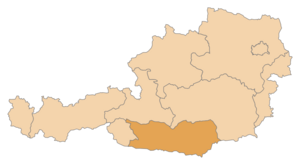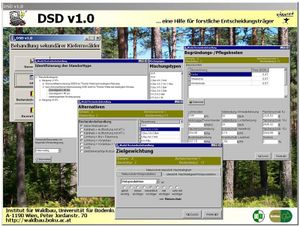Difference between revisions of "DSD"
m (new category) |
|||
| Line 8: | Line 8: | ||
DSS developed in order to support forest management in Kärnten's (southern Austria) [[:Category:Pinus sylvestris|Scots pine's]] forests. It deals with new stands establishment and treatment scheduling problems. | DSS developed in order to support forest management in Kärnten's (southern Austria) [[:Category:Pinus sylvestris|Scots pine's]] forests. It deals with new stands establishment and treatment scheduling problems. | ||
| + | [[Category:Finished articles]] | ||
[[Category:Decision support system]] | [[Category:Decision support system]] | ||
[[Category:Austrian DSS]] | [[Category:Austrian DSS]] | ||
| Line 115: | Line 116: | ||
=== System requirements === | === System requirements === | ||
| − | * Operating Systems: | + | * Operating Systems: Microsoft® Windows® OS |
| − | + | * Development status: v1.1 has been released | |
| − | * Development status | + | |
=== Architecture and major DSS components === | === Architecture and major DSS components === | ||
| Line 129: | Line 129: | ||
=== Documentation and support === | === Documentation and support === | ||
More information about DSD can be found at the [http://www.wabo.boku.ac.at/dsd.html?&L=1 DSD website], where e-mail directions of the responsible researchers are given. | More information about DSD can be found at the [http://www.wabo.boku.ac.at/dsd.html?&L=1 DSD website], where e-mail directions of the responsible researchers are given. | ||
| − | |||
| − | |||
| − | |||
| − | |||
| − | |||
Revision as of 19:35, 14 September 2009
General System description
System name: Decision Support Dobrova
Acronym: DSD
Brief overview
DSS developed in order to support forest management in Kärnten's (southern Austria) Scots pine's forests. It deals with new stands establishment and treatment scheduling problems.Contents
Scope of the system
DSD supports two main silvicultural decision-making problems, both for individual stands:
- The establishment of new stands. It seeks which species or species mixtures are suitable at particular locations within the project area, including considerations of the effect of climate change.
- Stand treatments scheduling, given a particular set of management objectives aiming at a future species-mixture stand type.
System origin
- It was developed by a researchers team in the Universität für Bodenkultur Wien. First prototype was implemented in 2001.
- how was it developed
- is it a commercial product
- Is in use in southern Austria.
Support for specific issues
Timber harvest effects, climate change effects, risk assesment methods, biodiversity, and site improvement.
Support for specific thematic areas of a problem type
- Silvicultural
- Certification
- Conservation
- Restoration
- Development choices / land use zoning
- Policy/intervention alternatives
Capability to support decision making phases
- Intelligence:
- DSD requires from the user the insertion of forest features data and management objectives.
- Design:
- For each stand objective different schedules and results are proposed, that then would be evaluated according to the management objectives.
- Choice:
- The selection among the different management possibilities is made according to the predefined objectives using multicriteria evaluation.
- Monitor:
- It falls on the final manager.
Related systems
Data and data models
Typical spatial extent of application
Stand level.
Forest data input
Stand characteristics are input via GUI.
Type of information input from user (via GUI)
Users have to assign a particular forest property to one of the predefined site and stand categories, usin some easily available stand characteristics. They also have to choose the management objectives among the predefined ones employing pairwise comparisons.
Models
Forest models
Growth and yield models are used to calculate costs and revenues. It has also an additive hierarchical utility model used in the multicriteria evaluation.
Decision Support
Definition of management interventions
Manager is able to choose among three objectives: timber production, nature conservation and biodiversity, or mantaining or improving site productivity.
Typical temporal scale of application
Depending on the objective, a short- to mid-term (i.e., 30 years) as well as a long-term planning horizon is distinguished.
Types of decisions supported
- Management level
- strategic decisions
- administrative decisions
- operating control decisions
- Management function
- planning decisions
- organizing decisions
- command decisions
- control decisions
- coordination decisions
- decision making situation
- unilateral
Decision-making processes and models
- Simulation (with and without stochasticity)
- Multiple criteria/ranking
Output
Types of outputs
Results can be viewed on the screen, stored in the database of DSD, and be printed in a comprehensive report.
System
System requirements
- Operating Systems: Microsoft® Windows® OS
- Development status: v1.1 has been released
Architecture and major DSS components
DSD was implemented in Borland(R) C++TM as a client/server architecture, with Oracle(R) as the relational database system. Thus, the inteface component of the program resides on the desktop computer of the user, and the application logic is on the central server of the forest region authorities.
The GUI is completely based on Borland's VCL (Visual C Library), and the generation of reports is based on QuickreportTM, which uses components of the Borland(R) C++TM programming environment.
Usage
DSD has been developed to support the staff of forestry extension services in the Dobrova region in preparing informed recommendations for forest management to small private landowners based on the owner's goal preferences.
Documentation and support
More information about DSD can be found at the DSD website, where e-mail directions of the responsible researchers are given.
References
External resources
- http://www.wabo.boku.ac.at/dsd.html (in German and in English)
- REYNOLDS K.M., TWERY M., LEXER M.J., VACIK H., RAY D., SHAO G,. et BORGES J.G.: Decision Support Systems in Forest Management IN BURSTEIN F. et HOLSAPPLE C. W. (EDS.) (2008): Handbook on Decision Support Systems 2: Variations. Springer Berlin Heidelberg. 800 pp.

